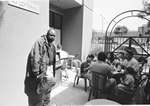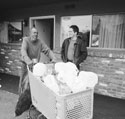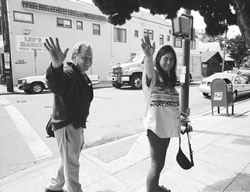Related Articles Case
Management versus Therapy
|
Bringing Them Inside:
Berkeley Mental Health workers provide services to help people with mental illnesses reclaim their lives. Story and photos by Richard Bermack May 2001 A man with a bright red complexion and long straggly blond hair paces back and forth, walking up and down the wheelchair access ramp in front of the Berkeley Mental Heath Clinic building. When he sees my camera and tape recorder, he stops his pacing. “I can get you an exclusive interview with John Lennon. You don’t believe me? I just spoke with him this morning,” he calmly proclaims and then walks off. Berkeley Mental Health received a $2.71 million grant under California Assembly Bill 2034 that allows it to provide intensive services to people who suffer from serious mental illnesses, homelessness, or repeated problems with the criminal justice system. BMH is using the three-year grant to expand its assertive community treatment(ACT)teams, which consist of clinicians, social workers, and other professionals. They allow workers to share resources and increase the time and services they can deliver to clients, many of whom are homeless. “It’s all about forming relationships with people,” states BMH homeless outreach worker Leland Johnson. To do that with mentally ill and homeless people takes a lot of patience and time, but the rewards are very fulfilling. He recalls one if his favorite cases: the girl at yogurt park.” The Girl at Yogurt Park When Johnson first met her, she was trying to get some
money to buy a yogurt dessert. She was disheveled, smelled bad, had sores
on her arms and wore rings on her fingers that were destroying her circulation.
She obviously suffered from a mental disability and was going to end up
in a psychiatric hospital. Johnson offered to buy her a yogurt. Johnson works closely with the crisis intervention team, and each day he checks hospital admission records. His breakthrough came when she was admitted to a hospital because of her skin disorder. One of the first goals in working with homeless people is to get them used to living inside. After a few weeks in the hospital, she got to that point. Johnson was then able to work with the hospital’s medical social worker to get her disability income and housing in a board and care facility. “Once in the board and care, we worked on her hygiene and socialization,” he says. Johnson’s next goal was to see if she had any relatives who could take care of her. “Mentally ill people have an inability to contact family, so you often have to rebuild the relationship and heal the wounds. You have to make sure the family is good for them. You don’t want to push people back to their family when the family may not have been supportive of the mental problems. “I finally got her to tell me where her parents
were. They lived in the Midwest, near where I grew up, and I used that
to form a bond with her. I remember that day. I had been working on getting
her to give me permission to call and then finally she said, ‘Yes,
you can call them.’ Johnson remembers taking her to the airport. “I
was explaining to her about the boarding pass, and a flight attendant
asked us if we needed any help. After I explained the situation, the attendant
said, ‘Don’t worry, we’ll take care of her from here on,’
and she assured me they would see to it that she got on her connecting
flight.” What Is Mental Illness? Not all homeless people are mentally ill. Often homeless outreach workers refer people to shelters or welfare advocacy groups that can assist them in getting whatever financial aid is available for housing or employment. However, if the person has a severe mental illness, Berkeley Mental Health provides services. Psychiatric social worker Josh Kirsch assesses clients and decides if they should be referred to psychiatric services. He then supplies the psychiatrist with background information to help in the diagnosis. “Mental illness refers to symptoms that people are experiencing in the here and now that cause them both intense suffering and functional impairment in terms of their ability to carry out tasks people would ordinarily be able to carry out, i.e., working, having a boyfriend or girlfriend, having social support, going to school. “People who are mentally ill suffer both from the
pain of their symptoms and from not being able to have the things that
healthy people have,” Kirsch explains. Many people have suffered
from childhood abuse, for example, and that abuse may cause the person
pain and difficulty functioning in a relationship. But someone diagnosed
with post-traumatic stress disorder may be having flash backs, experiencing
the childhood abuse as if it were still happening in the here and now. Bio-Psycho-Social Treatment “We do bio-psycho-social treatment,” Kirsch
explains. BMH workers focus on treating clients with biological imbalances
through psychiatric medication to control their symptoms. They work on
the psychology through therapy and getting the clients to understand their
symptoms and illnesses. Then they try to rebuild the clients’ social
situations by helping them form relationships, either with relatives or
with friends. BMH also has group activities, such as a drop-in cafe and
open houses. Outcomes “We are about outcomes,” Johnson explains. “We have to do with improving the quality of life. Everybody deserves a place to stay, a roof over their head, medical care, friends and the ability to get a job according to their ability. Those are the outcomes we are looking at. These people are at the lowest functioning level of society. We work with them and sometimes we get miraculous outcomes. If I reunite someone who hasn’t been with their family for 20 years, that is a significant outcome. Or the outcome may be that they die in a better place and have some peace with themselves, that is a different type of outcome. The state doesn’t allow you to look at that [in their outcome statistics], but Berkeley understands it is important.
|
||||||















 “The
most important thing is that it can be done. If you focus on people with
a humane approach and give them services, amazing things can get done.
I have seen people who were living on the streets, lying in the gutter
hallucinating their brains out, and now they are living inside, have a
decent job, are in a relationship, and taking care of themselves. That
is gratifying when you see the results. That is what it is all about.”
“The
most important thing is that it can be done. If you focus on people with
a humane approach and give them services, amazing things can get done.
I have seen people who were living on the streets, lying in the gutter
hallucinating their brains out, and now they are living inside, have a
decent job, are in a relationship, and taking care of themselves. That
is gratifying when you see the results. That is what it is all about.”